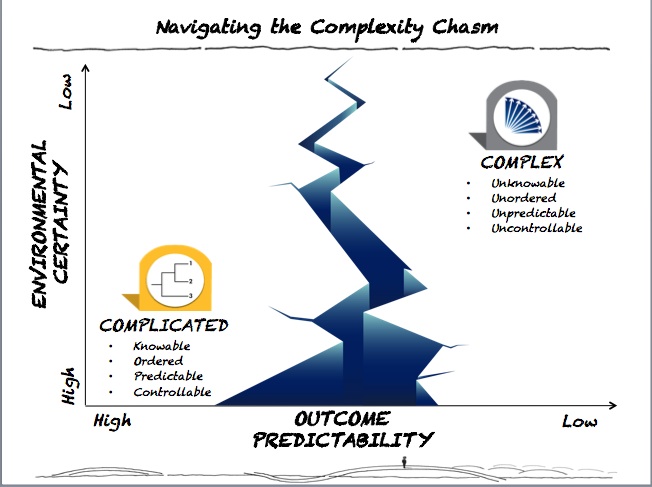
As the connectedness and complexity of an organization’s operating environment increases exponentially, its ability to accurately predict outcomes and anticipate disruptive shifts plummets precipitously.
In navigating today’s volatile, uncertain, and ambiguous world, organizations find themselves vacillating between complicated and complex operating contexts. Many end up plunging into the chasm that lies between them, resulting in their demise.
COMPLICATED CHALK AND COMPLEX CHEESE
In complicated operating contexts, the connection between cause and effect is knowable. Decision trees of possible outcomes can be identified, risks and probabilities around these outcomes can be calculated, and contingency plans for each path can be predetermined, controlled, and de-risked.
In complex operating contexts, the relationship between cause and effect cannot be predetermined. Both outcomes themselves and the paths to get there are emergent and cannot be controlled and de-risked ahead of time.
In short, they are completely different. Complicatedness is like chalk, while complexity is like cheese.

As leaders navigate between complicated and complex operating contexts, they must recognize which side of the chasm they are operating on and apply the leadership response required for that context.
In complicated operating contexts, leadership focuses on action path analysis, risk optimization, and control. To succeed, leaders must counteract their desire to over-analyze, avoid placing too much stock in the advice of subject matter experts, and overcome the blindness of their own biases.
Leaders seeking to navigate complex operating contexts must unlearn the lessons of experience they acquired in successfully navigating complicated ones. Complex operating contexts are unordered, unpredictable, and uncontrollable. They consist of polarities to be navigated, not problems to be solved, and they require a much more agile and adaptive leadership response.
To lead in a complex operating context, leaders must sense, learn, and respond; track assumptions and unknowns; identify patterns; develop insights; and discover high-leverage progression paths.
REFRAME, REWIRE, AND RECONFIGURE
To avoid peril in navigating the complexity chasm, leaders must reframe what they see, rewire how they think, and reconfigure what they do.
Leaders must reframe what they see by adopting a beginner’s mindset. Before answering a given question, leaders must engage others in questioning the question itself and synthesize the multiple diverse perspectives into a holistic appreciation for what is happening.
Leaders must rewire how they think by ensuring that every perceived mistake is reframed as an opportunity to learn and adapt. Tolerance for making mistakes and resilience in recovering from them is core to sense making.
Leaders must reconfigure what they do by choreographing actions and interactions between the informal network and the formal hierarchy that mobilizes and synchronizes discretionary effort around a particular progression path.
So when it comes to navigating complexity, always remember that it is not complicated!
Author’s Note: I’d like to thank the students of the Making Sense of Complexity Course in the Adaptive Strategic Execution Program at Duke for contributing their insights to this article.
Tony O’Driscoll is global head of DukeCE Labs, whose purpose is to discover what’s next for leadership development by experimenting with new methodologies, approaches, and technologies to uncover where leverage lies in building the leadership system capabilities required to survive and thrive in an increasingly complex world.

